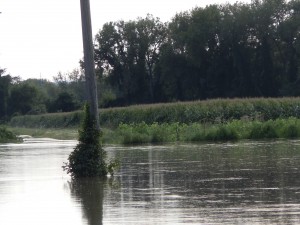Dear Climate Change Deniers: How Does YOUR Garden Grow?
Maybe my family’s organic garden (and my neighborhood) is a microcosm of the changes in the world ;-). We normally stop getting zucchini by the end of July. Last year, it went halfway through August. And this year, the one surviving plant finally died today, and I harvested the last two very tiny zukes on October 7. The season was approximately five weeks longer than usual,even though hey like hot weather and we pretty much didn’t have any.
Tomatoes, on the other hand, are normally extremely prolific until the first killing frost, usually very late in October. This year, the season peaked in early August, and even at its peak, we had far fewer than usual. I did manage to put a few pints of sauce in the freezer, and a few jars of dried tomatoes in the pantry, but the abundance that normally covers our entire counter never materialized—and the tomatoes had pretty much gone away by September 1, producing only one or two not-so-big tomatoes (many of them bloghted) and a handful of cherry tomatoes every few days since then. Normally, our six plants produce two or three dozen every day this time of year.
Our berry bushes were odd this year, too. The one blueberry plant gave one to two pints a day for about ten days, but one of our raspberry plants produced next to nothing, and the other a fairly paltry amount. On the very best day,I got half a pint. Ditto our blackberry bush. Normally,I’m able to put several pints by. This year, I managed to gather together and freeze a single half-pint of mixed blackberries and raspberries in July; we ate the rest as it came in, and it wasn’t much. But the bigger raspberry plant actually produced about eight very tasty fruits in September, a time when we’ve never gotten berries from it before.
Our celery was severely stunted, only about six inches high and mostly leaves, on very thin stalks. In the past, we’ve had celery that looked as good as supermarket varieties. We grew potatoes for the first time, and they came out great.
Nobody cultivates them, but I like to go gather Russian olives this time of year. I went to one of the two groves I know and found a total of one berry from several dozen plants. Fortunately, I know another grove, which was its usual prolific self.
Farmer neighbors who grow winter squash did not get a crop this year. Neither did several of the local apple farmers.
In short, not-normal is the new normal in the garden. Do you think, just maybe, global climate change has something to do with it?

